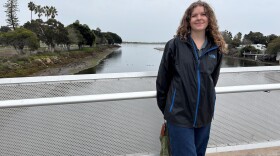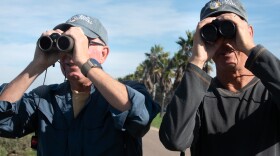MAUREEN CAVANAUGH (Host): It's one thing for grownups to find the perfect summer beach book. It's quite another to find books interesting enough to lure children away from the other joys of summer. With all the distractions online and outside, it's sometimes difficult to get kids to get into the slower pace of reading for pleasure. But if anything can do it, the list of children's books we'll be talking about today certainly can. I’d like to welcome my guest, Dr. Alida Allison, professor of Children’s Literature at SDSU. She reviews books for SDSU's Children's Book Review Service. Alida, thank you so much for coming in.
DR. ALIDA ALLISON (Professor of Children’s Literature, San Diego State University): It’s a pleasure to be here, Maureen. Thanks.
CAVANAUGH: And you brought such beautiful books with you.
DR. ALLISON: I know we’re on radio but I wanted to show some of them to you.
CAVANAUGH: I – And I love seeing them. Now, the publishing industry, we’ve heard a lot, has been struggling in recent years. Is that also true of children’s books?
DR. ALLISON: A lot less so. There have been layoffs in some of the bigger publishers but a lot less so and I think one reason is that the young adult titles like “Vampire” are providing a tremendous amount of interest and so children’s and young adult publishing tends to be better off.
DR. ALLISON: That’s interesting. Now, you know, we’ve also heard an awful lot about e-books and Kindles and the iPad. People sort of abandoning books and going to that – the electronic way of reading. Has that been affecting children’s literature at all?
DR. ALLISON: I think that’s a wonderful question because I didn’t know. I studied up this weekend. So what I learned was Amazon is not releasing sales figures of its Kindles. But I did a lot of searching on the web and here’s what I found out. E-books are not really that well suited to children’s books. For one thing, Kindle, for example, is black and white. The pleasure of picture books is the color and, of course, the beautiful art. But what publishers have been doing that’s so savvy and so smart is they’re taking advantage of children’s familiarity with the web. So a lot of books series now have their own websites, they have games…
CAVANAUGH: Ohh…
DR. ALLISON: …they have social networking, they have, of course, TV shows, and the commercial tie-ins, say, with “Shrek,” which, by the way, was originally a little children’s book by William Steig, have kept children interested and I think they’re still reading books. Books themselves, the look of them has changed, and that’s another adaptation that the industry’s been very savvy about keeping apace with.
CAVANAUGH: How has the look of children’s books changed?
DR. ALLISON: It’s a – If you look at a lot of contemporary magazines, you’ll see that they’re, what we call, multi-format. Every page has not just the, what we might call now, the authoritarian linear text where you just read like that, there’s – they’re multi-formats. They have little nuggets of information, they have a lot of insets, they have pictures, they have pull-tabs, they have flaps, they have pop-ups. Anything where a child’s hands can get involved with the book, as well as the child has the feeling that they’re choosing what they want to read when. It’s not just turn the page and it just continues.
CAVANAUGH: Right.
DR. ALLISON: They’re not as linear as they used to be.
CAVANAUGH: And, indeed, as you say, many of these books now have a web component so when they get finished reading the book, they can go online and play a game featuring the characters in the story.
DR. ALLISON: No, and it’s absolutely brilliant. The publishers have done very well with that. And people want – might want to go and check out some of the sites for their favorite authors. They’ll find that there are connections to websites for playing around with the books.
CAVANAUGH: Now, there was a time not long ago when it seemed like everyone was writing a children’s book, you know, Madonna wrote a children’s book. Is this still the case?
DR. ALLISON: Yeah, well, I think Madonna went on to write three or maybe even…
CAVANAUGH: Right.
DR. ALLISON: …four.
CAVANAUGH: Right.
DR. ALLISON: They were, you know, middling reviewed. Jerry Seinfeld, I remember, a few years ago did a Halloween book. The two authors I think that are the most well known and have done pretty well are John Lithgow, has three or four, maybe even five, really funny, very sophisticated, enjoyable, and then Jamie Lee Curtis is the other one. But, yeah, celebrities certainly have an in with the publishers.
CAVANAUGH: Yeah, I would imagine that is true. Yeah, names sell. Now when parents go to select a children’s book, do you have any criteria, any tips that – of what they should look for? What makes a good children’s book?
DR. ALLISON: I have lots of criteria but I’m not your child’s parent. You are. You know your kid best, and that’s the most important thing. Maybe take your kid with you to the library or, let me put it this way, your kid can take you to the library or to the children’s book store. I mean, Yellow Book Road is still there, it’s a wonderful store. My criteria are these: impact, that it has an emotional impact some way or other. Maybe it develops compassion. Maybe it develops a little sense of humor, but it has this impact. Second, depth, which is you learn something. It can be about another country, it can be about another time. These develop—impact and depth—develop passion, empathy, and also an idea of self-identity. The last one is style. Do you or does your child, I should say, like the way, the manner in which, the book is written? These are three important things. And some of the schlockier stuff out there—excuse the term but it’s true—lacks style or there’s no depth. You know, there’s nothing there but just the most superficial representation of the tawdriest aspects…
CAVANAUGH: I see.
DR. ALLISON: …most commercial aspects of our contemporary culture.
CAVANAUGH: Right. Can you tell us where that Yellow Book Road store is?
DR. ALLISON: Oh, sure. It’s in La Mesa. It’s on Parkway Drive in between Lake Murray Boulevard and Baltimore.
CAVANAUGH: I see.
DR. ALLISON: And, you know, we used to have a few very fine children’s bookstores in the county. My impression is that most of them, unfortunately, are gone but I know Yellow Book Road is still there.
CAVANAUGH: Let – Yellow Book Road. Thank you.
DR. ALLISON: Yes, b-o-o-k…
CAVANAUGH: Yes, okay. I’m speaking with Dr. Alida Allison, She’s professor of Children's Literature at SDSU. Now you do have some children’s book recommendations for us. And one of them is for very young readers and it involves that kind of tactile thing that you were talking about. It’s called “Stuff and Nonsense.” Tell us about it.
DR. ALLISON: Yeah, it’s by David Pelham, P-e-l-h-a-m. And it’s one of these books that I would call interactive. There are little mice in this book who are trying to build a town and everybody chips in and helps and they all bring different kinds of things, like aluminum. And the kid can touch the page and feel what aluminum feels like or can feel what the mouse’s fur feels like or the mouse’s whiskers. So this is what I mean by stimulating all of a child’s senses or as many as possible through a book. It’s not just reading, it’s not just listening, it’s not just visual anymore, it’s even this wonderful sensory…
CAVANAUGH: Right.
DR. ALLISON: …participatory kind of…
CAVANAUGH: And what ages are we talking about for books like that?
DR. ALLISON: “Stuff and Nonsense,” that’s a pop-up book and I’m sure most of your listeners know that this is a magnificently fertile field for children’s publishing as what we call novelty books. Matthew Van Fleet, Matthew Reingold (sic), Robert Sabuda, these are the guys who make the engineered books. They’re just beautiful works of art. They’re for whatever age you want. But parents need to be aware that the books are fairly expensive and they’re fairly easy to destroy. So you might want to, you know, have your baby on your lap or something like that. But “Stuff and Nonsense,” maybe three to six or something like that. It’s a little story. Matthew Van Fleet has a wonderful one called “Alphabet” that is also multi-sensorial. And I think a lot of children and adults would enjoy it.
CAVANAUGH: Now you also recommend a picture book called “Come Back Soon” and it’s really a remarkable book. What is it about, if you can tell us.
DR. ALLISON: But first I gotta say that I am indebted to my eternal mentor Peter Neumeyer, who was a professor here, my professor, and sort of started our Children’s Lit program here. He writes reviews for our children’s lit website, too, and this guy is a beautiful writer, writes for the Boston Globe. He did a long review for us that readers can find online. “Come Back Soon” is a book he recommended. It’s penguins in the South Pole, of course, in this very intricate kind of “Where’s Waldo” intricate little village, who invite an elephant architect to come and look at the work that he helped them build. The elephant being an elephant – he’s a really sweet guy but he’s a little big, there’s an accident, he fixes it, they help him and they invite him back. That’s the “Come Back Soon” part. The – You could – I was telling Maureen that you could spend a whole summer with your kid looking at this, there’s so much detail. Can’t recommend it highly enough, “Come Back Soon.”
CAVANAUGH: And the author?
DR. ALLISON: David Schallau, S-c-h-a-l-l-a-u, and it’s by Houghton-Mifflin.
CAVANAUGH: Now – And this, the age range for this would be around six, you think?
DR. ALLISON: Yeah, a six-year-old could be reading it by him- or herself. I mean, you can start sooner, and this is really a good book…
CAVANAUGH: Umm-hmm.
DR. ALLISON: …where you just have a little kid on your lap and you say things like, honey, what do you see? And the kid’s going to have a ball. I mean, there’s underwater villages in this. It’s very intricate. And you’re teaching your child to observe things, to notice relationships. So a world of fun just in this book.
CAVANAUGH: Now you brought us a book by an author whose name will be very familiar to NPR listeners, that’s Daniel Pinkwater.
DR. ALLISON: The wonderful Daniel Pinkwater who all of have heard doing reviews with Scott Simon…
CAVANAUGH: Right.
DR. ALLISON: …on Saturday mornings. Daniel Pinkwater is a wonderful example of an author who’s been around a long time. In the 1970s, he wrote the funniest book ever called “Fat Men from Space.” I recommend it highly. But since then, you know, he keeps writing. That’s what a lot of these authors do to make a living. He has a series of books about two bad bears, polar bears, that can’t resist stealing blueberry muffins that I very much recommend. The one that I brought in today is called “Beautiful Yetta: The Yiddish Chicken.” It takes place in San Francisco and it’s about how a lost chicken helps the parents of Telegraph Hill, who speak Spanish, by the way, since they’re from Latin America, she saves them and they invite her to stay with them forever. And it’s a book in which you find English, Yiddish, Hebrew and Spanish. So just for learning languages, I recommend it. In addition, to the wonderful sense of humor that Pinkwater has always had.
CAVANAUGH: And, indeed, it’s just a beautiful book.
DR. ALLISON: Umm-hmm.
CAVANAUGH: Let’s move up in age now to the young adult books because, as you mentioned in the beginning, that – they’re really fueling this publishing in children’s literature. One book that you recommend is a graphic novel.
DR. ALLISON: This is a book called “Tyranny.” It’s by Leslie Fairfield. And I used it with my Adolescents In Literature class just last semester. We all learned a lot from it. The tyranny is – the main character is anorexic and here’s a situation in which the visuality of the graphic novel really helps because it’s hard for people who aren’t anorexic to understand. But one of the most startling illustrations has the girl herself—and she, the author, was anorexic—and to our eyes she looks perfectly normal, right? But she’s looking at herself in the mirror and you see what she looks like to herself and, of course, she’s just obese which she’s really not. This book with the visual really added a lot of depth to understanding the compulsiveness of this. She’s not an abandoned teenager. She has a supportive family and yet she has to go through, you know, some real hard times to overcome this condition.
CAVANAUGH: And you have identified a trend in young adult fiction right now that you call ‘the mean girl’ genre. What do you mean by that?
DR. ALLISON: First, I have to say that’s not my particularly…
CAVANAUGH: All right.
DR. ALLISON: …my favorite genre. I tend to go for fantasy. But I have noticed reading so many publishers’ categories that they have page after page of books with titles like “Blood,” “Thirst,” “Swoon,” “Impulse,” “Privilege,” “Entrapment,” “Cash,” “Hunger,” “Private.” You get the idea.
CAVANAUGH: Yes.
DR. ALLISON: And they’re sort of a cross between the vampire books, a lot of them are that. Boy, if you go to any bookstore, there are tons of those. But some of them are just what I would call gossip girls in literature kind of things. There’s a series called “Goddess Girls” where they’re very much like the gossip girls only their names are things like Athena. I think it reflects a contemporary perception of what high school is like but maybe your listeners are more familiar with them than I am. They’re just a lot of them.
CAVANAUGH: And tell us what you think about the “Twilight” series.
DR. ALLISON: I read the first one. I have nieces, may I say, who are crazy about them. I have not pursued them. I didn’t make it a particular study. I just know they’re tremendously popular and that they have led into books like “Blood,” “Impulse,” “Swoon,” “Afterlife,” all kinds of things. And I suppose they just tap into a very romantic notion of love being tinged with danger and sharp teeth, I guess. I don’t know.
CAVANAUGH: Now this is the 50th anniversary year for the publication of two classic books for young people. Tell us what they are.
DR. ALLISON: One is a book I think a lot of people have read. It’s “The Island of the Blue Dolphins.” Fifty years later, it’s alive and well. Still a magnificent book. It has a lot of words in it, so I wonder, you know, if people are reading it as much as they used to. I think it’s still required, I mean, at all the schools.
CAVANAUGH: It doesn’t have all the pop-ups, right?
DR. ALLISON: No, it doesn’t. And then the other one is a reissue of Leo Leone’s picture book called “Little Blue and Little Yellow.” And this is, you know, about getting along and they make green together. It’s very nice. Also another one that just came – that recently had a 50th anniversary is “To Kill A Mockingbird,” which bears rereading. It’s a remarkable book.
CAVANAUGH: Can you tell us just a little bit about the SDSU Children Book Review Service?
DR. ALLISON: Yeah, I’m so glad to tell people that this is a book review site that’s free. It’s accessible by just going to childlit.sdsu.edu. The reviewers are faculty like myself and a lot of our graduate students, plus our wonderful children’s librarian, Linda Salem, and publishers send us a couple of thousand books a year, which is something we’re very grateful for. Twice or three times a year we post new reviews. There’re usually 50 – between 50 and 100 of them, each posting, and they’re there for the public and your listeners, and we just hope that the word gets out and more and more people use the site.
CAVANAUGH: Well, what a wonderful resource. And I really want to thank you for coming in. Thank you for bringing the books in, too, even if I’m the only one who got to see them. I’m sure you can online. Let me tell you once again, hundreds of books are reviewed each year as part of SDSU’s children’s book review service. You can look online at childlit.sdsu.edu and click book reviews. Dr. Alida Allison, thanks so much.
DR. ALLISON: Thank you, Maureen. Thank you.
CAVANAUGH: And if you’d like to comment on what you’ve heard, go online, KPBS.org/thesedays. Coming up, the executive director of Human Rights Watch tells us about allegations of abuse in Mexico. That’s as These Days continues here on KPBS.







